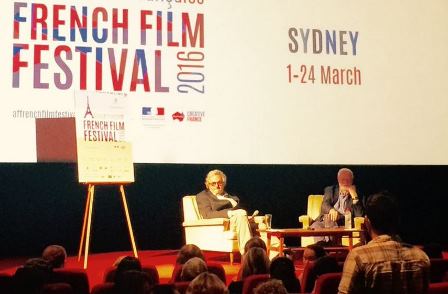George Miller and David Stratton in conversation.
David Stratton and George Miller had a wide-ranging chat at the Chauvel last night as guests of the French Film Festival, of which both are patrons.
Miller described growing up in Chinchilla, where he fell in love with movies during the saturday matinees at the local cinema, which was his "secular cathedral".
He also praised Stratton's tenure at the Sydney Film Festival and its influence on a generation of Australian filmmakers.
Miller's short, Violence in the Cinema, Part 1, played at the festival in 1971, as part of the Benson and Hedges awards.
The cigarette manufacturer was the only company willing to sponsor a festival for Australian shorts, joked Stratton, who also queried the title of Miller's short – "there was never a part two".
Violence in the Cinema starred Arthur Dignam, and was programmed before a film by Vittoria de Sica. Miller recalled his excitement at seeing it in the official program.
Realising shorts would never make any money, Miller and producing partner Byron Kennedy decided to make a feature, cobbling together $350,000 from friends and family to make the first Mad Max.
Miller said that Hugh Keays-Byrne – Toecutter in the original and Immortan Joe in Fury Road – had come to Australia as an actor in Peter Brook's touring production of A Midsummer Night's Dream, and ended up staying here.
Keays-Byrne "taught me so much about acting", said Miller. "[After Mad Max] I waited over thirty years to work with him again".
Stratton reviewed the film for Variety, in which he called Miller an ex-dentist rather than ex-doctor ("Same thing", said Miller).
American International picked up the 1979 film and dubbed it, to the chagrin of the cast and crew.
Miller recalled that Keays-Byrne's RSC buddies went along to see the film in London, only to hear a southern American accent, badly synced, come out of Toecutter's mouth.
Miller bumped into Rebel Wilson recently on the awards season merry-go-round, who told him that she comes up with an American accent on every film, but is always told to revert back to her native twang.
"That's cultural evolution", said Miller.
Despite being worked over, Mad Max still managed to win over international fans. Miller said he was wowed when he heard that Roman Polanski liked the film.
Stratton recalled meeting the Coens for the first time, who, upon hearing he was Australian, immediately asked if he knew George Miller.
When Miller finally returned to his most famous character, it was the beginning of the longest gestation period of his career.
"Fury Road was basically locked in its concept back in 2000", said Miller.
When the shoot finally got underway in Namibia, Miller's biggest worry was injury to his cast and crew – "not only on-set but on the road travelling to locations".
The film's beginning and end – the scenes featuring the large paddle-wheel treadmills powered by war-boys – were shot back home at Sydney's Fox Studios.
Where the original Mad Max had a crew of around thirty, Fury Road corralled around nine hundred people on-set, the director estimated, and many more in post.
Stratton also touched briefly on Miller's other films, such as Lorenzo's Oil – "it's a wonderful, wonderful film, George" – and the Babe films.
Miller said he was often asked why the man behind Mad Max would make family films, and pointed out that, as a parent, one rarely has the chance to watch anything else, and that the impact of the films he saw as a child could be staggering: "I remember the first time I ever saw Pinocchio. It's an extraordinary film".
Asked by an audience member about the push to recognise stuntwork within the Academy, Miller said he supported it but that "The Academy had too much on their plate this year".
While Miller's opinion of the #OscarsSoWhite controversy was not canvassed, his attitude towards Australian crews was, and he spoke effusively about Australian cameramen like his Fury Road DOP John Seale.
"They're elegant about how they run their teams. They're relaxed but firm, with a relaxed discipline that's very powerful. I'm not saying it's just Australian crews, but it's pretty much the case".


